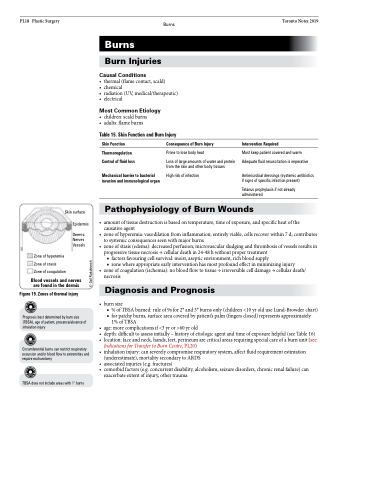Page 1140 - TNFlipTest
P. 1140
PL18 Plastic Surgery
Burns
Toronto Notes 2019
Burns
Burn Injuries
Causal Conditions
• thermal(flamecontact,scald)
• chemical
• radiation(UV,medical/therapeutic) • electrical
Most Common Etiology
• children:scaldburns • adults:flameburns
Table 15. Skin Function and Burn Injury
Skin Function
Thermoregulation Control of fluid loss
Mechanical barrier to bacterial invasion and immunological organ
Consequence of Burn Injury
Prone to lose body heat
Loss of large amounts of water and protein from the skin and other body tissues
High risk of infection
Intervention Required
Must keep patient covered and warm Adequate fluid resuscitation is imperative
Antimicrobial dressings (systemic antibiotics if signs of specific infection present)
Tetanus prophylaxis if not already administered
Zone of hyperemia Zone of stasis
Zone of coagulation
Blood vessels and nerves are found in the dermis
Figure 19. Zones of thermal injury
Prognosis best determined by burn size (TBSA), age of patient, presence/absence of inhalation injury
Circumferential burns can restrict respiratory excursion and/or blood flow to extremities and require escharotomy
TBSA does not include areas with 1° burns
Skin surface
Epidermis
Dermis: Nerves Vessels
Pathophysiology of Burn Wounds
• amountoftissuedestructionisbasedontemperature,timeofexposure,andspecificheatofthe causative agent
• zone of hyperemia: vasodilation from inflammation; entirely viable, cells recover within 7 d; contributes to systemic consequences seen with major burns
• zoneofstasis(edema):decreasedperfusion;microvascularsludgingandthrombosisofvesselsresultsin progressive tissue necrosis → cellular death in 24-48 h without proper treatment
■ factors favouring cell survival: moist, aseptic environment, rich blood supply
■ zone where appropriate early intervention has most profound effect in minimizing injury
• zoneofcoagulation(ischemia):nobloodflowtotissue→irreversiblecelldamage→cellulardeath/
necrosis
Diagnosis and Prognosis
• burnsize
■ % of TBSA burned: rule of 9s for 2° and 3° burns only (children <10 yr old use Lund-Browder chart) ■ for patchy burns, surface area covered by patient’s palm (fingers closed) represents approximately
1% of TBSA
• age:morecomplicationsif<3yror>60yrold
• depth:difficulttoassessinitially–historyofetiologicagentandtimeofexposurehelpful(seeTable16) • location:faceandneck,hands,feet,perineumarecriticalareasrequiringspecialcareofaburnunit(see
Indications for Transfer to Burn Centre, PL20)
• inhalationinjury:canseverelycompromiserespiratorysystem,affectfluidrequirementestimation
(underestimate), mortality secondary to ARDS
• associatedinjuries(e.g.fractures)
• comorbidfactors(e.g.concurrentdisability,alcoholism,seizuredisorders,chronicrenalfailure)can
exacerbate extent of injury, other trauma
© Gail Rudakewich


